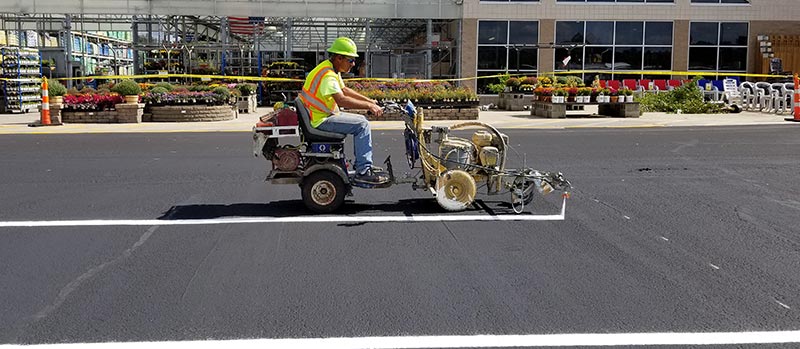A1 Professional Asphalt & Sealing Llc Things To Know Before You Get This
A1 Professional Asphalt & Sealing Llc Things To Know Before You Get This
Blog Article
The Facts About A1 Professional Asphalt & Sealing Llc Uncovered
Table of ContentsLittle Known Questions About A1 Professional Asphalt & Sealing Llc.Rumored Buzz on A1 Professional Asphalt & Sealing Llc3 Simple Techniques For A1 Professional Asphalt & Sealing LlcWhat Does A1 Professional Asphalt & Sealing Llc Do?The A1 Professional Asphalt & Sealing Llc PDFs

The oil in a car engine is not simply oil. The REOB contains all the ingredients that were in the waste oil as well as the wear steels from the engine (mainly iron and copper).
By making many blends using various REOB examples and various asphalt binders, the variants mostly can be balanced out. Numerous States offered examples of known REOB structure to TFHRC scientists, who assessed the examples to contrast the percent of added (known) REOB to the discovered (checked) quantity. The evaluations revealed an equivalent percentage of included and found REOB.
7 Easy Facts About A1 Professional Asphalt & Sealing Llc Explained
None of those States realized that the asphalt they were buying had REOB. One State urged its samples had no REOB - https://qualtricsxm4qwdsn59g.qualtrics.com/jfe/form/SV_0H8SwRAI7gGMMQK.
Of the 1,532 samples evaluated, 12 percent consisted of REOB, and some consisted of considerably high degrees of it at 1020 percent. The highest degree was 34 percent in a sample from Texas, which TxDOT had used in a patching substance. This screening likewise exposed the visibility of phosphoric acid in 11 percent of the examples, and 2 percent consisted of ground tire rubber.
2 years earlier at TRB's yearly meeting, the Federal scientists held an REOB workshop and presented the searchings for of their lab examinations to a standing room-only crowd. Some firms do not specifically ban REOB, they do impose physical tests that prevent its useeffectively a ban. Others do not prohibit it by specification, however have arrangements with asphalt providers to stay clear of using REOB
What Does A1 Professional Asphalt & Sealing Llc Do?
A handful do enable REOB, some within particular limitations. Ohio and Texas limitation levels to less than 5 percent of the asphalt. To establish a reliable test technique that all States can utilize, the TFHRC scientists established up a round-robin examination strategy. The participants are 11 State freeway firms (Illinois, Massachusetts, Minnesota, Mississippi, Montana, North Carolina, Oklahoma, South Carolina, Texas, Vermont, and Wyoming), 2 independent screening laboratories, the Ministry of Transport in Ontario, Queen's University in Ontario, and an Ontario paving professional.
In overall, the researchers prepared and shipped 720 blends. The individuals are evaluating the examples individually making use of the guidelines provided by the TFHRC researchers. The round-robin screening is almost finished, and TFHRC is in the process of gathering the results. The output will certainly be a suggested AASHTO test method that any kind of State can adopt and use (asphalt sealcoating in st louis).
The pavement with REOB, which is situated 0.6 mile (1 kilometer) from the pavement without REOB, has identical subgrade, website traffic density, and climate. Nonetheless, the section of Highway655 with 5 to 10 percent REOB revealed significant cracking. In this instance, the visibility of REOB was the determined cause of splitting at a reduced temperature levels.
"In our experience in copyright, also tiny quantities of 23 percent can be a trouble." An area of examination sidewalk in Minnesota (MN1-4) found to consist of REOB likewise fractured prematurely. The pavement carried out well for the initial 3 to 4 years, but then started to crack. This sidewalk is additionally subject to low temperature levels.
A1 Professional Asphalt & Sealing Llc - An Overview
The tests were not considerable, yet they revealed that at levels of 6 percent or more, the tensile strength of the asphalt dropped considerably. At a level of 3.5 percent REOB, the variation in the physical examination techniques was higher than the impact of REOB. It was challenging for scientists to evaluate whether REOB was existing. https://www.imdb.com/user/ur180438932/.

One binder parameter taken into consideration is the difference between the low temperature level critical specification temperature for rigidity (S) in the flexing beam of light rheometer and the bending beam rheometer creep incline (m-value) noted as Tcritical. TC = TC (S) TC (m-value). Evaluation of this criterion is still continuous. Two independent research study teams, one from AASHTO and the other from the Asphalt Institute, ended that even more research is required on the use of REOB in asphalt.
Formerly, all asphalt testing gauged engineering properties such as rigidity. These tests do disappoint what materials had been included in the asphalt. One example obtained throughout the TFHRC study had an extremely strange evaluation. The sample had the complying with examination results: Superpave PG 64-28 with a heat grade of 67.3 Tcritical on the bending beam rheometer was 6.7 degrees Celsius.

The smart Trick of A1 Professional Asphalt & Sealing Llc That Nobody is Discussing
These results demonstrate there are weak points in the standard engineering testing methods that might be made use of. like it The manufacturer may have an economic advantage and the item passes all the standardized tests, but the product may not be beneficial to ensuring long-lasting performance. To address this problem and the expansion of brand-new asphalt additives and extenders, TFHRC is starting a research program to make use of handheld spectroscopic gadgets, x-ray fluorescence spectroscopy, and Fourier change infrared spectroscopy to allow analyses to be carried out in the field rather than having to take samples back to the laboratory.
Report this page